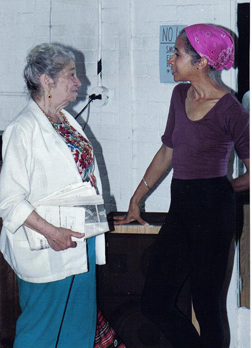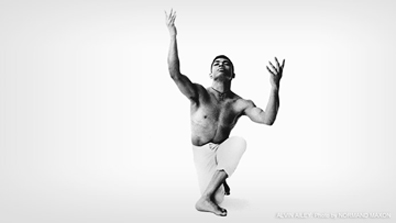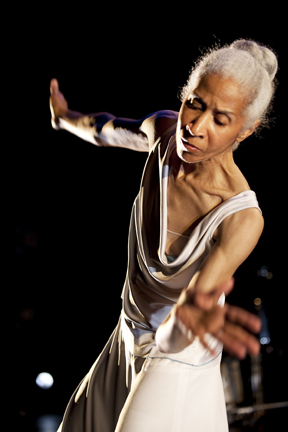Dance: Clark Center
By Jennifer Dunning
ART TIMES Spring 2016
 Louise Roberts, director of Clark Center (Photo: Martha Swope) |
When I think of Clark Center what comes first to mind, even before the countless dance artists whose feisty, vital work I cherish today, is an event that took place in the late 1980's in an I-Hop on a grey highway in the middle of nowhere in North Carolina. It was a rainy morning. My breakfast companion was Louise Roberts, the last artistic director of the Clark Center for the Performing Arts, as it was more formally known. The choice of eateries was Louise's and she (and I) attacked our mile-high stacks of pancakes with as much gusto as she brought to everything else in life.
Suddenly, from across the noisy room, there was a loud cry of "Louise? Louise Roberts?" She looked up and beamed at the young man who made his way toward her through the crowd of diners. He had performed at Clark Center. She remembered him, she said. And they embraced like old friends and talked. And talked.
Louise and I were on our way to visit Edele Holtz in Swannanoa. Edele had been the founding director of Clark Center and Louise wanted to interview her and take a look at her archival material. I was there to talk with Edele and her husband, Al, for a biography I was writing on Alvin Ailey. It was Ailey who was ultimately responsible for the founding of Clark Center, that small bustling home for dance and to a lesser extent theater, including the Playwrights Horizon. Many of the dancers and choreographers were young and new to the profession and needed an affordable clean place to rehearse, take class and see their work welcomed, taken seriously and produced professionally.
Clark Center has been in the news recently with events curated by Jill Williams, director of a re-emerging Clark Center, that throw more light on 30 invaluable years of dance. Perhaps a little history is in order here.
It all started with an impossible-seeming quest. Charles Blackwell, a dapper, genial black stage manager, had worked with Ailey in the 1957 Broadway musical "Jamaica." It had become clear to him that this new, charismatic young modern-dance choreographer was destined for great things after a much talked-about first New York program presented in 1958. Ailey would need affordable office space and room to rehearse, perform and store company paraphernalia.
With one exception, the city's rehearsal places did not welcome black dance artists. And that exception offered only studios, though they were cleaner and more spacious than most. (In one Broadway facility, a dancer recalled, newspapers made a path across the filthy floor from the dressing room to the studios, where you could rent a few feet to rehearse in. Solemn modern- dance choreographers could find themselves working through a new piece to the din of nearby Spanish and tap dancers' clattering feet.)
Clark Center, Ailey would later say, "was the only reason we were able to continue."
Accompanied by Robert Buccolo, a white Broadway technical director, Blackwell went in search for a home for the Ailey dancers. They finally found one in a newly opened YWCA on Eighth Avenue and 51st Street, headquarters for the Clark Center until the building was sold in 1974.
 Snapshot of Louise Roberts and Dianne McIntrye early 1970s |
Louise kept the dance school going in a dark impromptu space nearby. She presented a provocative summer dance series for three years in the mall at the CUNY Graduate Center on West 42nd Street, which ingeniously drew its audiences from casual passersby, novice dancegoers in many cases who lingered bravely. In late 1982 Clark Center acquired the perfect space, a small theater farther west on Theater Row that would be everything Louise had dreamed of, renovated to her specifications.
I remember so clearly Louise's excitement, followed by as close as she ever got to despair when the deal collapsed in 1985 after a bit of shameless political sleight-of-hand by the city's Parks and Recreation Commission. Back to the bad old days. Clark Center was now a peripatetic institution that somehow managed to continue presenting high-quality dance by grassroots and established talents until it closed in 1989.
American modern dance was founded in large part by women, often exotic and driven by visions of what must be communicated through movement and music. There was nothing exotic about Edele or Louise, small energetic women who let very little slow them down. Neither suffered fools gladly. They were both ruthless in accomplishing their goals. But how different they were!
The formidable Edele was a crisply elegant Danish-American social worker with finely drawn features. Louise was an endearing roly-poly rumpled mess with an earthy sense of humor, her hair always flying from her hastily assembled bun. I can still see the two sitting face to face in Edele's neatly appointed living room, warily reminiscing as Edele's husband watched with deceptive casualness from a near distance.
The Holtzes were not theater people. They had worked for a decade setting up Quaker refugee and education programs in the Middle East. Charged with reaching out to New Yorkers living in the vicinity of the newly opened Westside Y, formerly the Capitol Hotel, Edele and her staff had been searching for a population to serve in the neighborhood, home not just to glittering theaters but to grim tenements as well. As the Y increasingly became a hub for new dance, with Ailey playing pied piper, Edele had to find a way to keep the Board women from discovering that those served were actually performers in search of endless free rehearsal time in big, freshly painted (though barebones) new studios. Her target population, she assured the Board, was young black theater women.
Edele's long hours of work were divided between running the Center and helping the seat-of-the-pants Ailey troupe to survive and flourish. Her hapless husband was pressed into maintaining the company's books, a thankless task. But somehow the Center grew as a home for dance. The activities included not only rehearsals but classes taught by noted modern-dance choreographers of the day and performances in the hotel's quickly renovated ballroom, a theater space where Ailey and his dancers appeared a month after the formal opening.
 Alvin Ailey by Normand Maxon |
The heart of the programs was the long-lived New Choreographers Concert series, suggested by Ailey, in which young unknowns cut their teeth and became experienced artists, particularly under Louise's keen-eyed ministrations. One such artist was Dianne McIntyre, a dancer, choreographer and teacher who is a prominent much-admired modern-dance "elder" today.
Louise was a pragmatic hands-on mentor. McIntyre decided she wanted to move on to "a concert with dancers" after performing a solo in a 1971 New Choreographers Concert, at the start of her career. Why not do that here? Louise suggested. But McIntyre was hesitant about how to do it. First hold an audition for dancers, Louise suggested, then put up a sign with the performance dates and whether the dancers would be paid or not.
But Louise, nobody knows me, McIntyre worried. No one will come. They will, she was told. "People are hungry to dance." And she was right.
The pieces, in a shared program, were received with wild applause. Louise had come to every performance and confirmed that the evening was a hit. "But that last piece you did to live music is a little too long," she added. Undiscouraged, McIntyre dreamed about creating her own company. Louise urged her to create a manifesto. Write about why you dance and what your objectives are, she said. McIntyre would have free space at Clark Center until she made money. Then she would have to pay. That was quintessential Louise, a no-nonsense mother hen.
Louise was careful not to show favoritism, but extra enthusiasm managed to make itself felt. She had a fond spot for black dance artists, including McIntyre and Pepsi Bethel, a jazz dancer and choreographer who was her special favorite. George Faison, who performed and choreographed on Broadway and modern-dance stages, was another. But she also admired Hinton Battle, a classically trained black ballet dancer. And one of her greatest loves was Kei Takei, a Japanese post-modernist whose stark theater-dance pieces Louise admired greatly.
Many of her "finds" went on to major dance careers, among them Laura Dean, Meredith Monk and Bill T. Jones. But what drew me most to Louise was her knack for finding the oddballs we both cherished, creators whose voices and dance intelligence were unmistakably their own.
 Dianne McIntyre, dancer and choreographer (Photo: AntoineTempe) |
Two that I remember fondly were Susan Dibble and Harry Streep. Dibble's 1976 "Sextet Foranna" looked as if it had been inspired by gorilla movement. Six dancers crouched, stamped, loped and swung their way from one point to another, pausing occasionally for lumbering embraces as they passed through groupings that might have been assembled by Rodin. This was the kind of implicit story, springing from pure movement and without a plot, that dance can tell so singularly. And I remember Streep -- yes, his sister is an actress -- and his Human Arms troupe in the mid-70's for their fresh, clean-lined dance and stories of everyday people told with engaging modesty and performed with the gutsy unaffected energy of basketball players.
Both Dibble and Streep went on to other careers in the arts. Jones became an internationally celebrated choreographer. You could see that coming very early on in his 1976 "Everybody Works," a solo in which the tall, slender dancer wore high Kabuki-style clogs that made even simple walks about the stage seem awkward and risky.
The movement was about as simple as movement can be. But in those moves -- careful, precise and seething with barely contained emotion that powerfully suggested the complicated adaptation of someone, black like Jones, to a society in which he will always be "different." There was in the dance something of the cutting social commentary of work by Eleo Pomare, another of Louise's finds, but tempered to steel by stark post-modernism. Whether or not Jones intended his solo to be experienced in that way, "Everybody Works" instantly communicated the inherent metaphoric power of dance.
Louise left Clark Center in 1986, after 16 years. The Center closed in 1989. It is almost impossible to imagine an Edele, a Louise or a Clark Center putting down roots today in New York's less adventurous dance scene. When I think today of Louise, it seems remarkable that she ended up so passionately in love with dance and people. She had come to Clark Center from careers as a city welfare worker and the manager of the June Taylor Dance School, where the high-kicking Taylor dancers, featured on television revues of the 1950's and 60's.
Louise once told me of a indelible experience when, at 18, she returned to ballet training. She was short and compact. Not a "dancer's body." And so she was ignored until, as her body curved into a deep back-bend, the teacher announced "Look, it can move."
Louise, Edele and Clark Center gave dancers the chance to move, to create, whether or not they had the right kind of build, skin color or bank account. It was an incredibly rich experience for dancegoers like me, a feast of just about every kind of dance in the most welcoming of atmospheres. Risks were taken and certainly there were some dismal failures. But the Center offered everyone the opportunity to take chances, on stage or in the audience.
Anna Kisselgoff once described Clark Center as "a state of mind" as much as a physical space. That it was. And how lucky we all were.
(Jennifer Dunning has written for publications including the New York Times, where she was a staff dance and general culture writer. She is the author of Alvin Ailey: A Life in Dance, and books on Geoffrey Holder and the School of American Ballet. She lives in NYC. )
